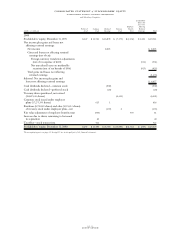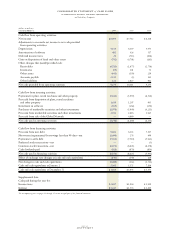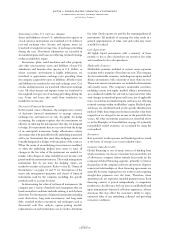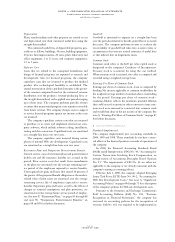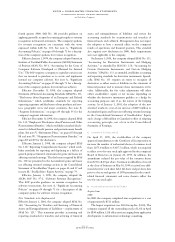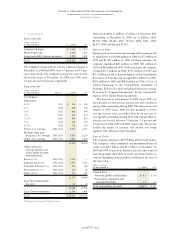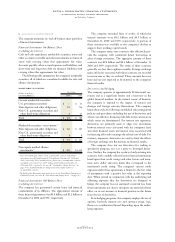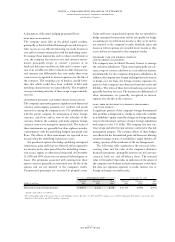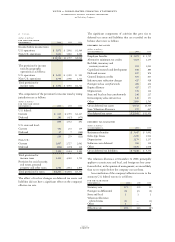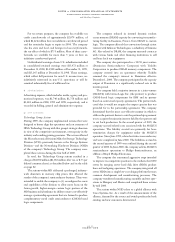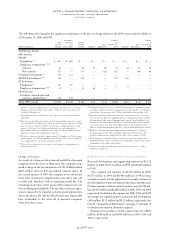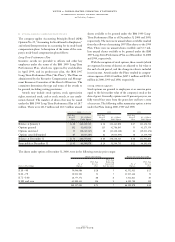IBM 2000 Annual Report Download - page 79
Download and view the complete annual report
Please find page 79 of the 2000 IBM annual report below. You can navigate through the pages in the report by either clicking on the pages listed below, or by using the keyword search tool below to find specific information within the annual report.
At December 31, 2000 At December 31, 1999
Notional Carrying Fair Notional Carrying Fair
(dollars in millions) Value Value Value*Value Value Value*
Derivative financial instruments $«18,873 $«(21) $«178 $«31,535 $«(198) $«(437)
Amounts in parentheses are liabilities.
*The estimated fair value of derivatives both on- and off-balance sheet at December 31, 2000 and 1999, comprises assets of $393 million and $616 million, respectively, and
liabilities of $215 million and $1,053 million, respectively.
A description of the major hedging programs follows:
DEBT RISK MANAGEMENT
The company issues debt in the global capital markets,
principally to fund its Global Financing lease and loan port-
folio. Access to cost-effective financing can result in interest
rate and/or currency mismatches with the underlying assets.
To manage these mismatches and to reduce overall interest
cost, the company uses interest-rate and currency instru-
ments, principally swaps, to convert a portion of its
fixed-rate debt into variable-rate debt and to convert a por-
tion of its variable-rate debt to fixed-rate debt. Interest rate
and currency rate differentials that arise under these swap
contracts are recognized in interest expense over the life of
the contracts. The resulting cost of funds is usually lower
than that which would have been available if debt with
matching characteristics was issued directly. The weighted-
average remaining maturity of these swaps is approximately
six years.
ANTICIPATED ROYALTIES AND INTERCOMPANY TRANSACTIONS
The company’s operations generate significant non-functional
currency intercompany payments for royalties and goods
and services among the company’s non-U.S. subsidiaries and
with the parent company. In anticipation of these foreign
currency cash flows and in view of the volatility of the
currency markets, the company selectively employs foreign
currency contracts to manage its currency risk. The terms of
these instruments are generally less than eighteen months,
commensurate with the underlying hedged anticipated cash
flows. The effects of these instruments are reported in net
income when the underlying transaction occurs.
For purchased options that hedge qualifying anticipated
transactions, gains and losses are deferred and recognized in
net income in the same period that the underlying transac-
tion occurs, expires or otherwise is terminated. At December
31, 2000 and 1999, there were no material deferred gains or
losses. The premiums associated with entering into these
option contracts generally are amortized over the life of the
options and are not material to the company’s results.
Unamortized premiums are recorded in prepaid assets.
Gains and losses on purchased options that are intended to
hedge anticipated transactions and do not qualify for hedge
accounting are recorded in net income as they occur and are
not material to the company’s results. Similarly, gains and
losses on written options are recorded in net income as they
occur and are not material to the company’s results.
SUBSIDIARY CASH AND FOREIGN CURRENCY
ASSET/LIABILITY MANAGEMENT
The company uses its Global Treasury Centers to manage
the cash of its subsidiaries. These centers principally use cur-
rency swaps to convert cash flows in a cost-effective manner,
predominantly for the company’s European subsidiaries. In
addition, the company uses foreign exchange forward contracts
to hedge, on a net basis, the foreign currency exposure of a
portion of the company’s non-functional currency assets and
liabilities. The terms of these forward and swap contracts are
generally less than one year. The interest rate differentials of
these instruments are generally recognized in interest
expense over the life of the contracts.
LONG TERM INVESTMENTS IN FOREIGN SUBSIDIARIES
(“NET INVESTMENT”)
A significant portion of the company’s foreign denominated
debt portfolio is designated as a hedge to reduce the volatility
in stockholders’ equity caused by changes in foreign exchange
rates in the functional currency of major foreign subsidiaries
with respect to the U.S. dollar. The company also uses cur-
rency swaps and other foreign currency contracts for this risk
management purpose. The currency effects of these hedges
are reflected in the Accumulated gains and losses not affecting
retained earnings section of stockholders’ equity thereby off-
setting a portion of the translation of the net foreign assets.
The following table summarizes the notional value,
carrying value and fair value of the company’s derivative
financial instruments, principally interest rate and currency
contracts, both on- and off-balance sheet. The notional
value at December 31 provides an indication of the extent of
the company’s involvement in these instruments at that time,
but does not represent exposure to credit, interest rate or
foreign exchange rate market risks.
notes to consolidated financial statements
international business machines corporation
and Subsidiary Companies
page no.
seventy-seven


